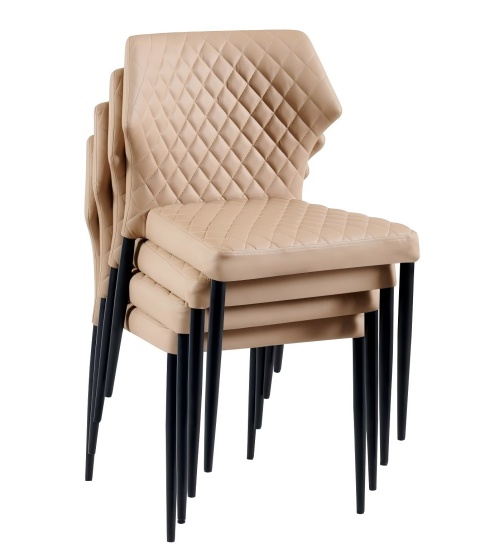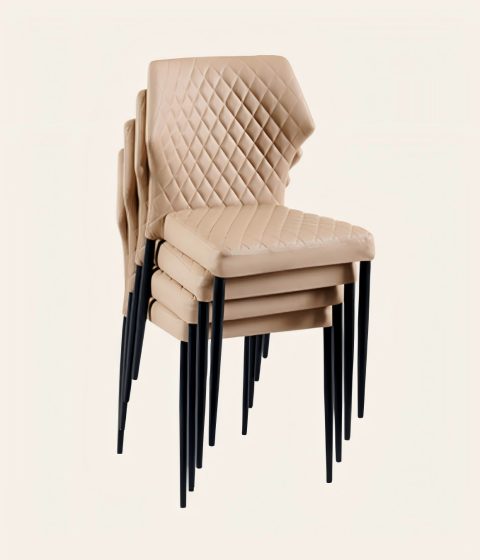Stackable Dining Chairs in Europe: Market Trends and Insights

Ever step into a cozy Berlin café or a lively Madrid family kitchen and notice how everything just fits perfectly? That’s the magic of stackable dining chairs doing their thing. Here in Europe, where space often comes at a premium—especially in those charming but compact city apartments—these chairs aren’t just furniture. They’re problem-solvers. We’re taking a closer look at what’s fueling the demand for stackable dining chairs across Europe, from new trends to some surprising insights. Whether you’re a homeowner trying to maximize a small dining area or a restaurant owner dealing with busy rushes, this article is for you. Let’s get into it.
Understanding the Rise of Stackable Dining Chairs
Stackable dining chairs have evolved. They’re no longer just a practical add-on. Nowadays, they play a central role in how Europeans design their living spaces. Take cities like London or Paris—getting more crowded each year. People are constantly searching for smart ways to make their homes more functional. These chairs stack up neatly, freeing up floor space. Maybe for a morning yoga session or a spontaneous dance party with friends.
Why Stackable Dining Chairs Are Gaining Ground
It’s straightforward: versatility meets real-life needs. Imagine a small Amsterdam apartment where the dining area also works as a home office. Stackable chairs can be tucked neatly under the table or placed in a corner when not in use. The numbers tell the same story—the global stackable chairs market reached around $3.5 billion in 2023 and is expected to hit $5.9 billion by 2032. Here in Europe, the broader furniture market is expanding too. It was valued at $222 billion in 2024 and is likely to climb to $296.5 billion by 2033, growing at a steady 3.3% each year. These aren’t just stats—they reflect a move toward smarter living.
But it’s not only about small spaces. Restaurants and cafés all over Europe love these chairs for easy storage after hours. I once talked to a bistro owner in Rome who absolutely relied on them. Stack them high, and you suddenly have room for an extra wine delivery without stumbling over chair legs.
European Preferences Shaping the Market
Europeans have a real talent for mixing style and function. Unlike heavy traditional chairs, stackable models here often feature clean silhouettes and modern materials. Think metal frames paired with leather seats, or lightweight plastics that still offer comfort. The dining chairs market overall is growing—from $16.2 billion in 2024 to an expected $25.7 billion by 2033, with a 5.5% annual growth rate. Stackables are part of that growth, especially in hospitality where quick setup matters.
Preferences also change from region to region. Up in Scandinavia, people love minimalist designs using sustainable wood—eco-friendly looks are a priority. Down in Italy or Spain, you’ll find more focus on sturdy, weather-resistant options perfect for outdoor dining all year. Here’s another insight: the plastic furniture market in Europe is expanding fast, with an 8.3% yearly growth through 2027. Lightweight stackable models are leading that trend.
Current Market Trends for Stackable Dining Chairs in Europe
The market for stackable dining chairs in Europe isn’t stuck in place. It’s changing with new consumer habits, tech upgrades, and even some post-pandemic rethinking. Here’s what’s happening, based on recent reports and conversations with suppliers.
Space efficiency is driving demand. With 74% of Europeans living in urban areas, stackable chairs can save up to 50% more space compared to non-stacking options, according to furniture efficiency studies. Cafés in packed cities like Barcelona totally get this.
Sustainability is another major force. Green is definitely in. About 60% of European buyers now consider eco-materials when shopping. That means more chairs made from recycled plastics or FSC-certified wood. These are better for the planet—and often easier on your budget as production increases.
Then there’s multifunctional design. Chairs that swivel, adjust in height, or even fold are growing popular. The restaurant chairs segment alone went from $4.21 billion in 2024 to a projected $4.50 billion in 2025. Stackables are a favorite for their flexibility—great for events or pop-up dining spots.
Here’s a quick overview of growth in related categories:
|
Market Segment |
2024 Value (USD Billion) |
Projected 2033 Value (USD Billion) |
CAGR (%) |
|
Global Stackable Chairs |
3.5 |
5.9 |
~6.0 |
|
Europe Furniture Overall |
222 |
296.5 |
3.3 |
|
Dining Chairs |
16.2 |
25.7 |
5.5 |
|
Plastic Furniture (Europe) |
N/A |
N/A |
8.3 |
|
Restaurant Chairs |
4.21 |
5.8 (by 2029) |
~6.8 |
These numbers show that stackable dining chairs aren’t just a temporary trend—they’re part of a bigger shift in how we use space.
Sustainability as a Core Trend
Let’s be clear: Europeans care deeply about the environment. EU rules on waste are getting stricter, so makers are switching to biodegradable composites. One great example? Chairs made with frames from recycled ocean plastic, popping up in cool spots across the Netherlands. It’s not always smooth—supply chains can be tricky—but the effort pays off. Brands using eco-labels often see sales jump 20-30%.
Design Innovations and Material Shifts
Innovation is keeping things exciting. Look for diamond-stitched upholstery on metal legs for that industrial look, or ergonomic curves that support you through long meals. Leather remains a go-to for its toughness, but plastics are on the rise. Globally, demand for stackable and foldable plastic chairs shot up 28%, and that’s reaching Europe too, appealing to budget-aware shoppers. And colors? Khaki and neutrals are big—they blend into modern decor without dominating the room.
Insights from the Industry: Real-World Applications
Looking beyond the numbers, stackable dining chairs make a real difference in daily business. In hospitality, they help manage space efficiently. A Vienna café might stack twenty chairs in minutes, turning the dining area into a lounge for the evening crowd. Industry experts notice that B2B suppliers are crucial here, offering custom orders—like batches of 300 chairs with lead times of 30 to 45 days—feeding into European wholesale markets.
Another interesting angle: the kids’ market. Europe’s children dining chairs segment hit $1.5 billion in 2024 and is expected to reach $2.8 billion by 2033, growing at 7.5% per year. Stackables are perfect for families—easy to clean and store away after messy meals. Still, challenges remain. Supply issues from global events can push prices up 10-15%, pushing buyers to look for local options.
There are plenty of opportunities too. Online shopping is blowing up. Sellers use virtual try-ons, which cut return rates in half. And with remote work still common, home offices often double as dining spaces, increasing the need for flexible furniture.
Forest Furniture: Your Reliable Supplier for Stackable Dining Chairs

Speaking of suppliers, let’s talk about Forest Furniture. They’re a trusted B2B furniture maker based in Tianjin, China, with several factories across northern China. They produce a wide range of items, from solid wood tables to upholstered chairs, and they don’t cut corners on quality. Their stackable dining chairs—like the Everett model with diamond-stitched khaki upholstery and black metal legs—are made for today’s interiors. They work well in homes, cafés, or restaurants where saving space matters.
What makes them special? Customization is simple. You can change colors, materials, or packaging to suit your needs. They load up to 680 pieces per container and typically deliver within 30–45 days, making them ideal for bulk orders. Their goal is simple: provide dependable furniture that helps businesses succeed, built on a foundation of skill and new ideas. If you’re sourcing for the European market, their global network—including partners in Europe—makes them a strong choice for stackable chairs that combine looks, strength, and practicality.
Conclusion
Stackable dining chairs in Europe are more than a passing trend. They’re adapting to the way we live, work, and socialize. From the green movement to smart designs that save space, this market has strong momentum. All signs point to continued growth, thanks to tight urban living and a greater focus on sustainability. Whether you’re shopping for new chairs or just curious about the industry, these insights reveal a market full of possibility. And when you’re ready to make a move, suppliers like Forest Furniture are there to help.
FAQs
What are the key market trends for stackable dining chairs in Europe right now?
Right now, stackable dining chairs in Europe are leaning heavily into sustainable materials and versatile designs. With city living becoming more common, lightweight plastics and metals are popular for easy storage. Eco-friendly options like recycled materials are also big. The market is growing around 5–8% each year in related areas, driven by the needs of restaurants and homes short on space.
How do stackable dining chairs fit into modern European homes?
In tight European apartments, stackable dining chairs are perfect for saving room. You can stack them and free up floor space until you need them again. They’re practical for small families or when you have guests over. The designs often match clean, simple styles in places like Scandinavia or more colorful decors in Mediterranean countries.
Are there any insights on the future demand for stackable dining chairs in Europe?
Future demand looks strong. Europe’s furniture market is expected to hit $296.5 billion by 2033. More online shopping and flexible living after the pandemic mean people want furniture that adapts. There can be issues like material costs, but custom options are making these chairs more available to everyone.
Why choose leather for stackable dining chairs in Europe?
Leather brings durability and a classy touch to stackable dining chairs in Europe. It stands up well in busy homes or restaurants, is simple to clean, and stacks without scratching. It fits right in with the trend for high-quality yet practical furniture, especially in cooler regions where comfort is key.


